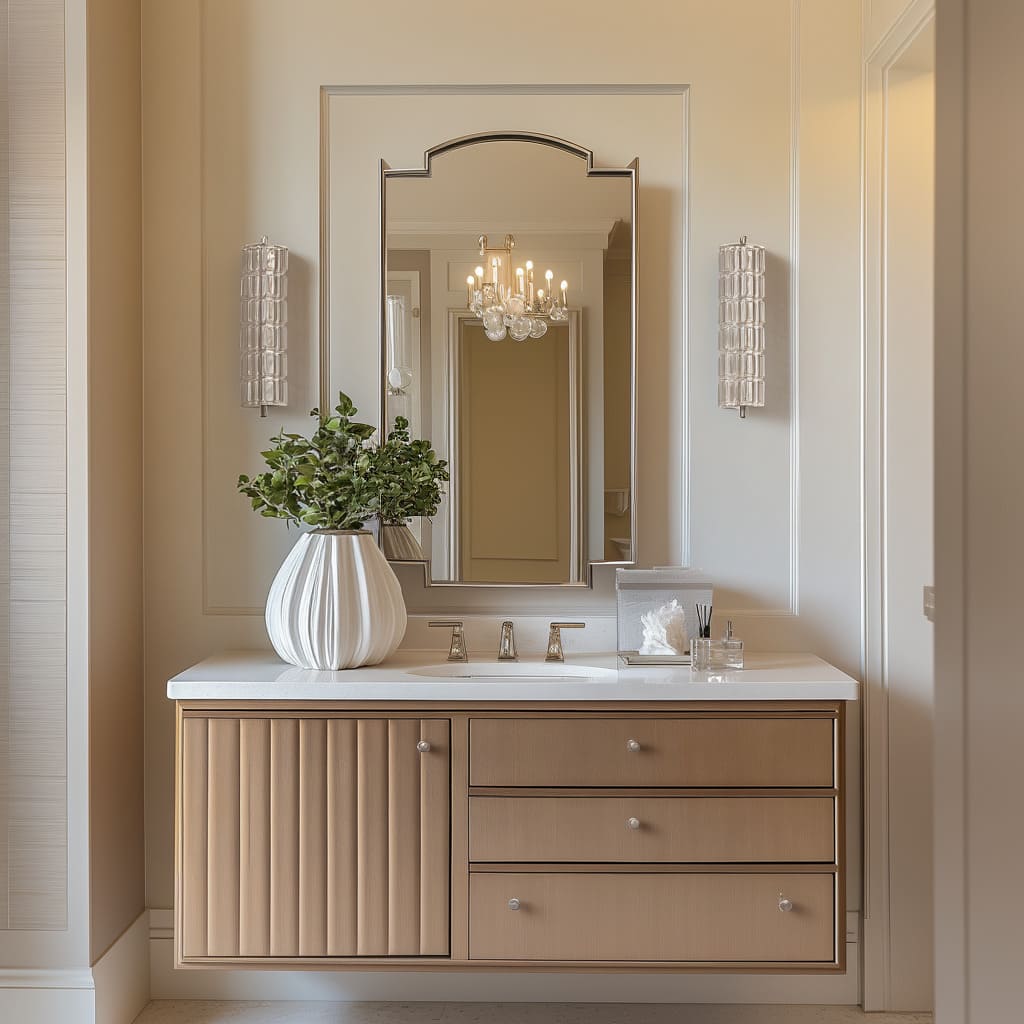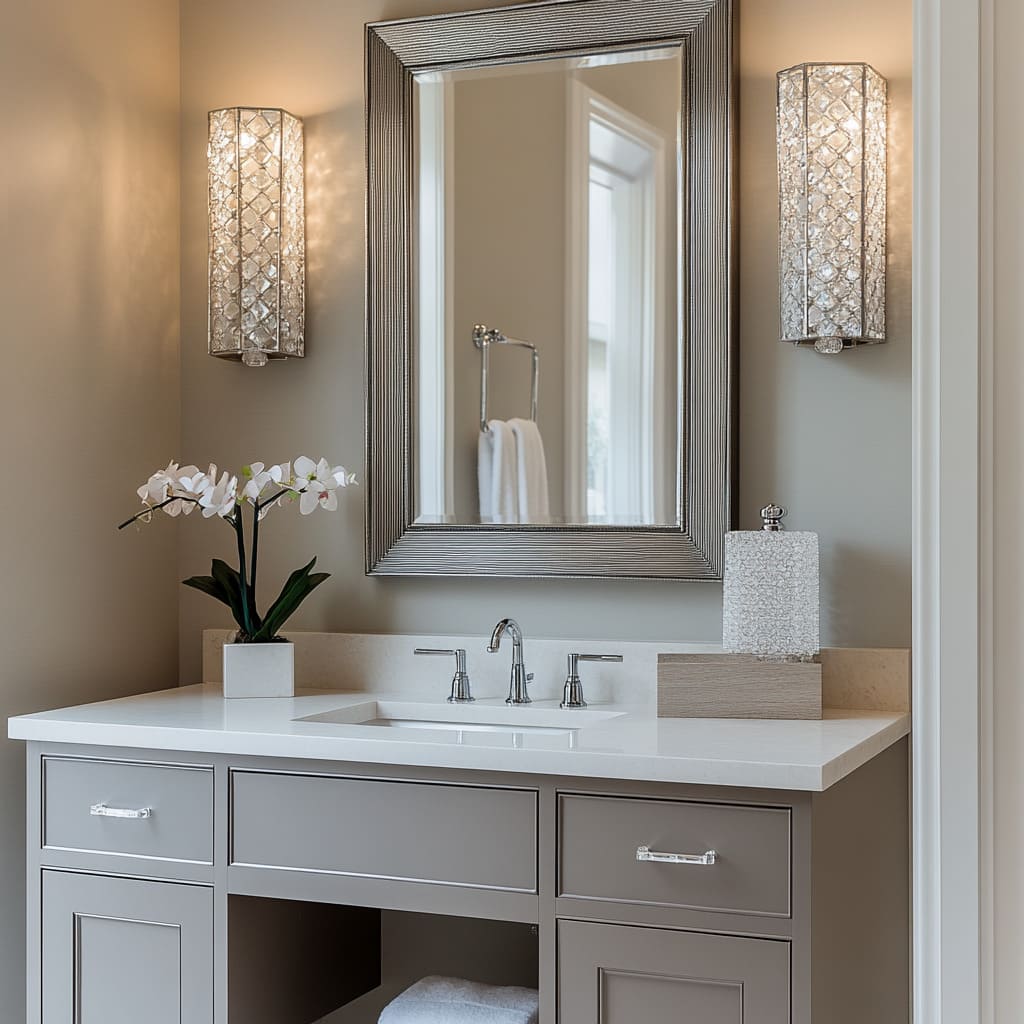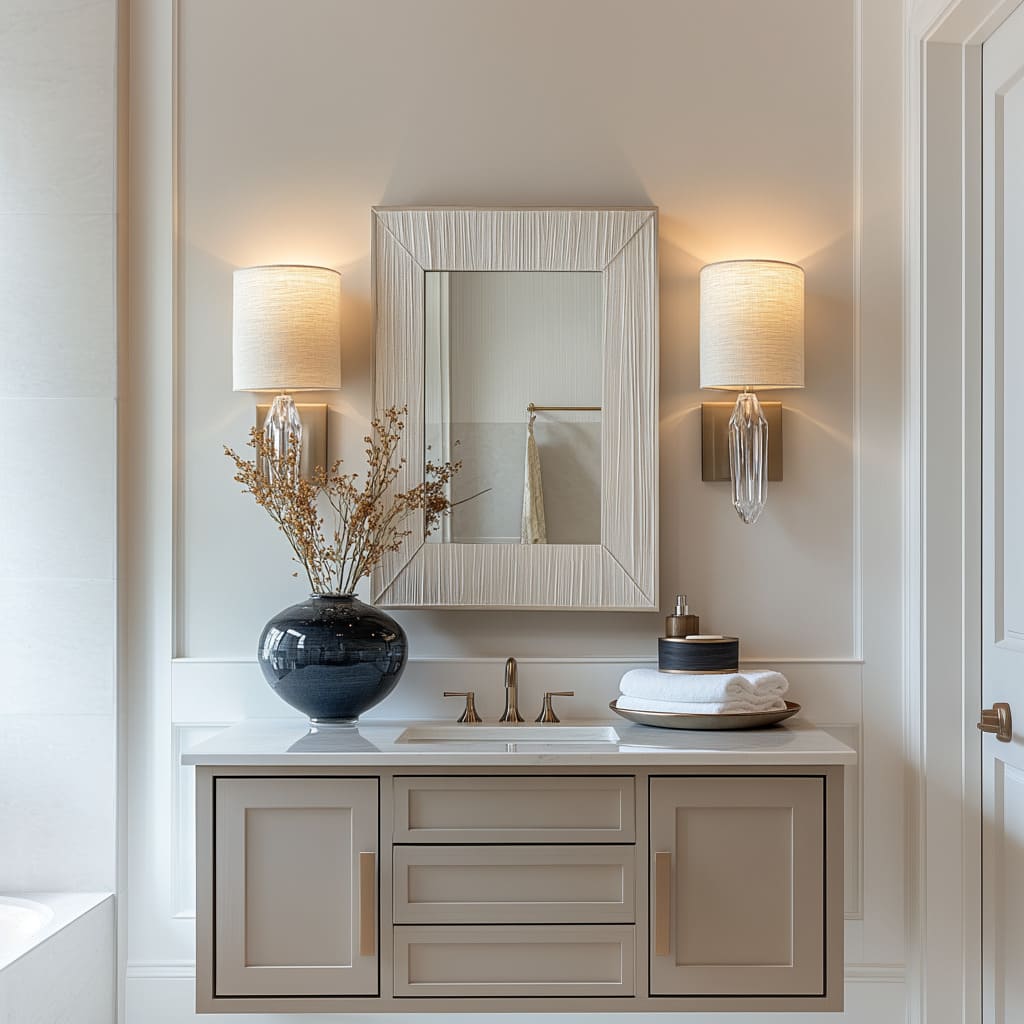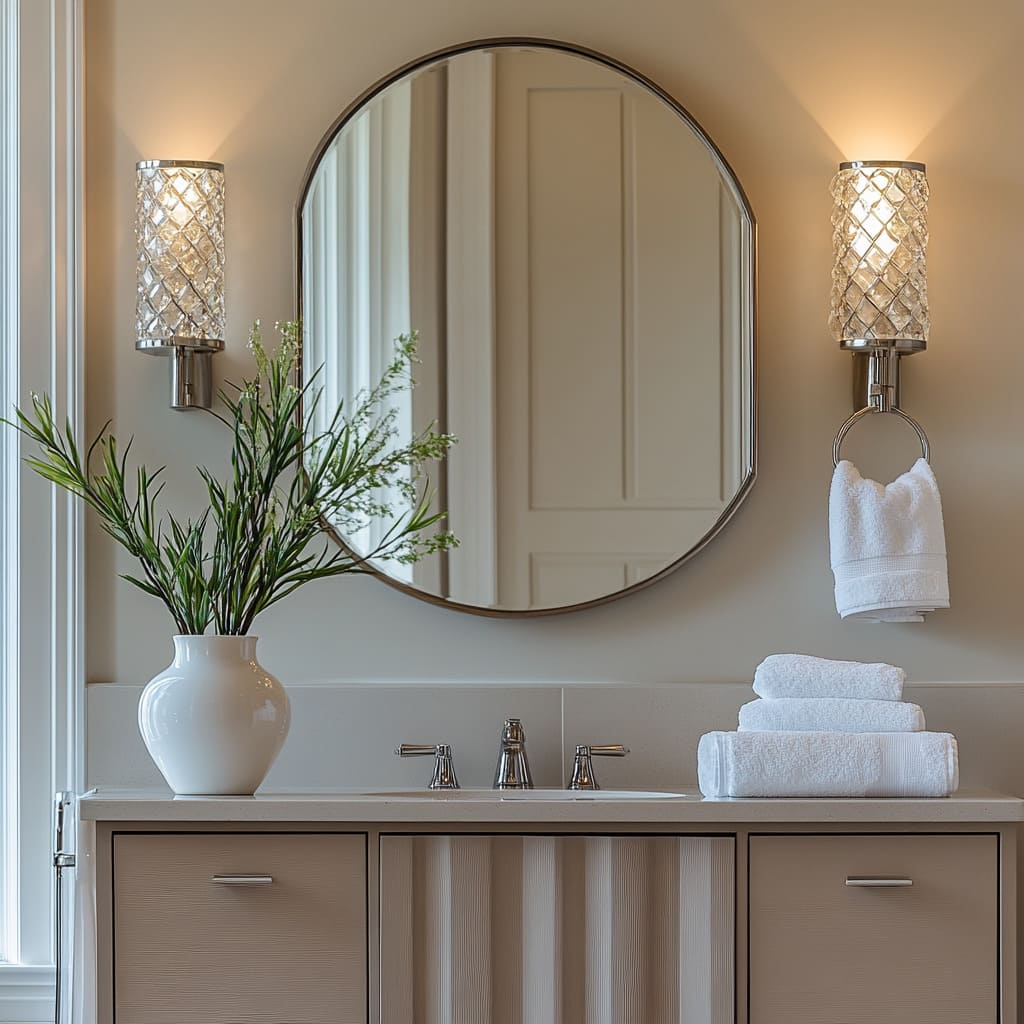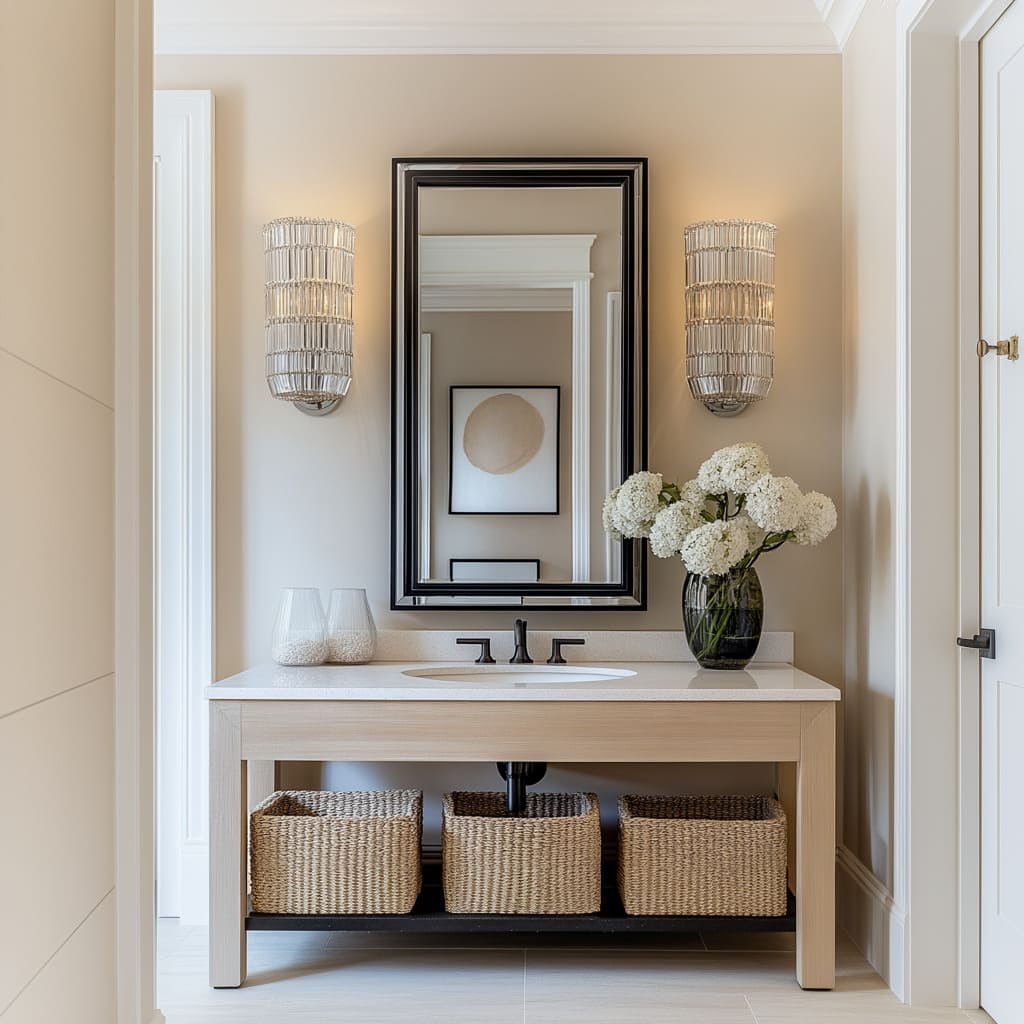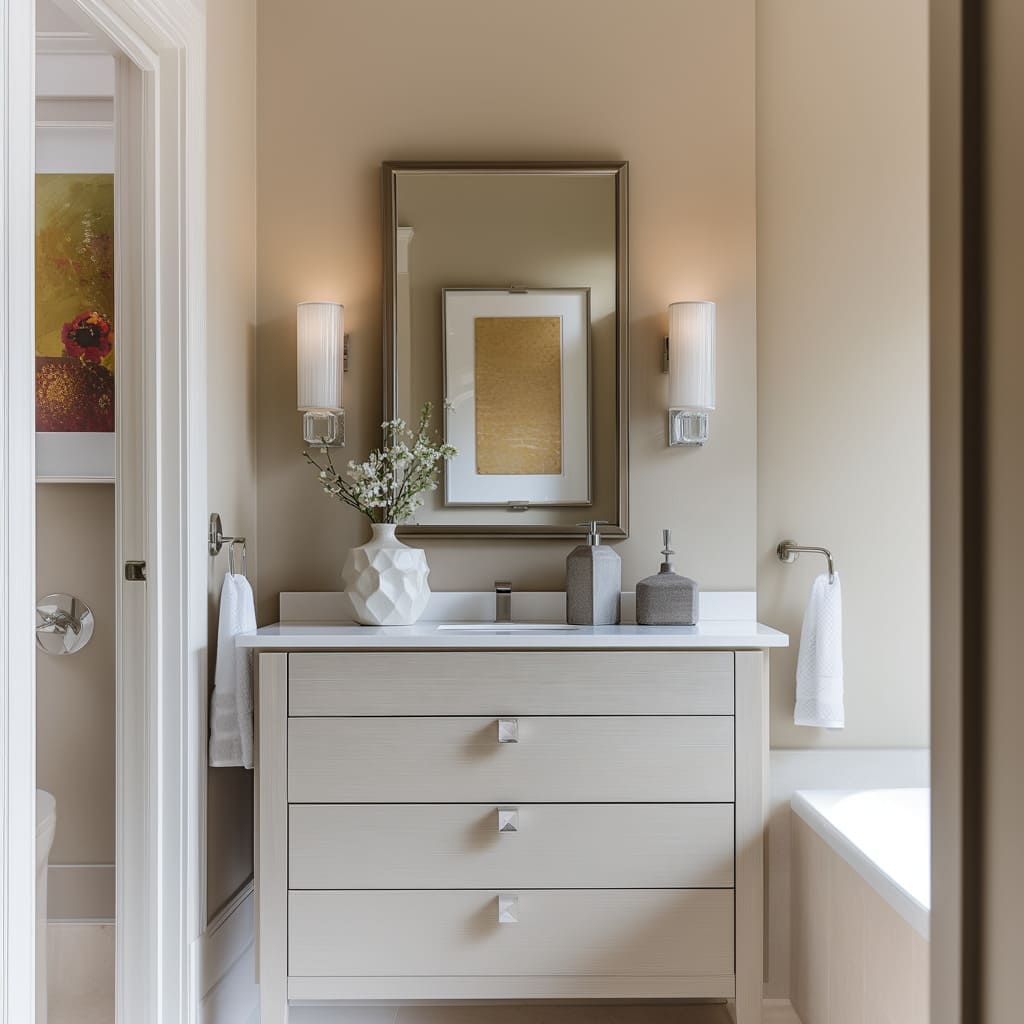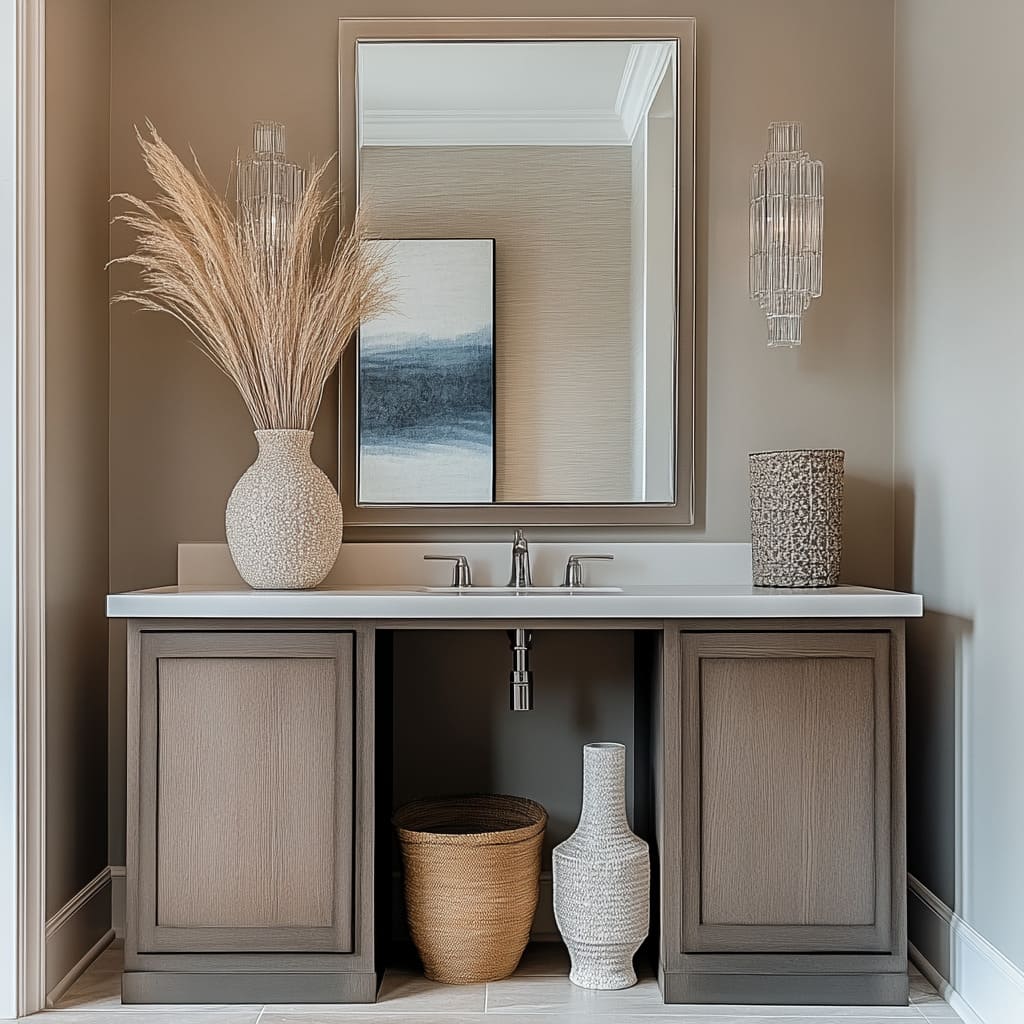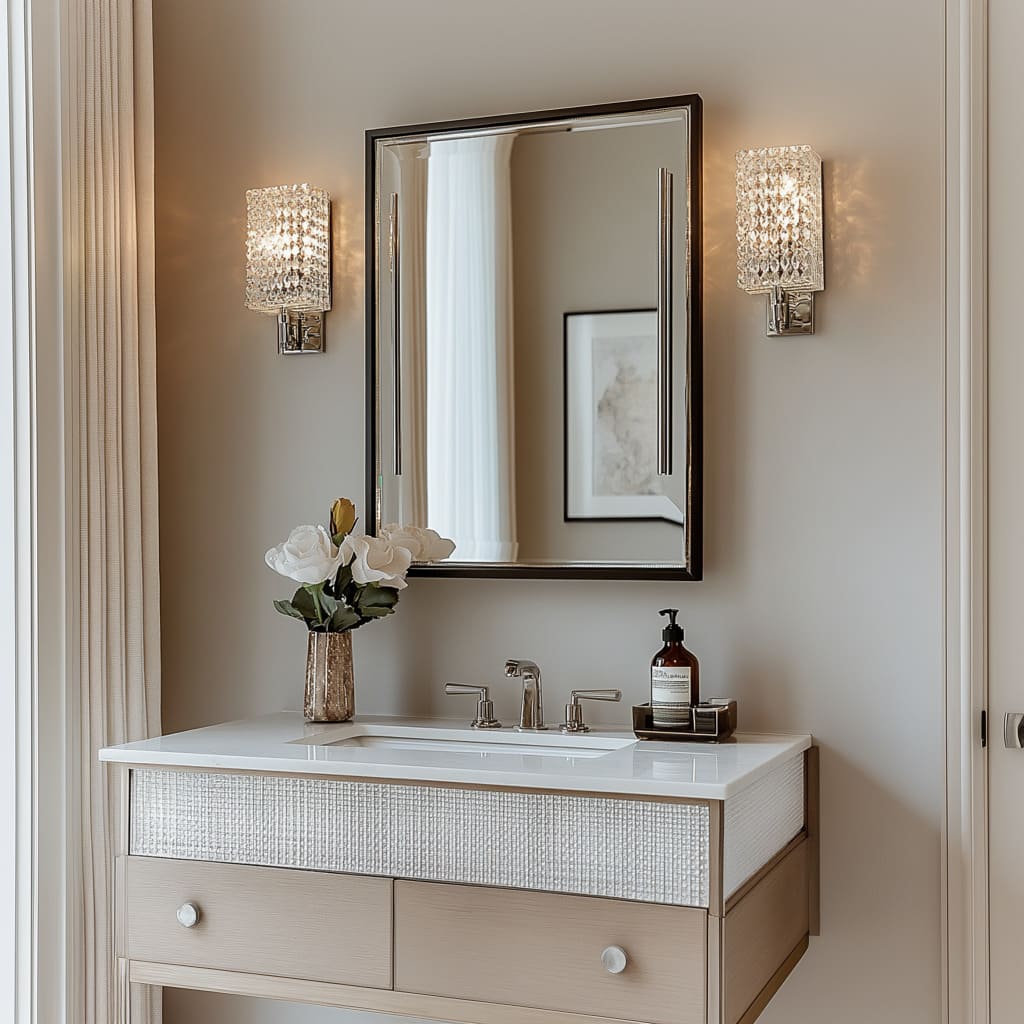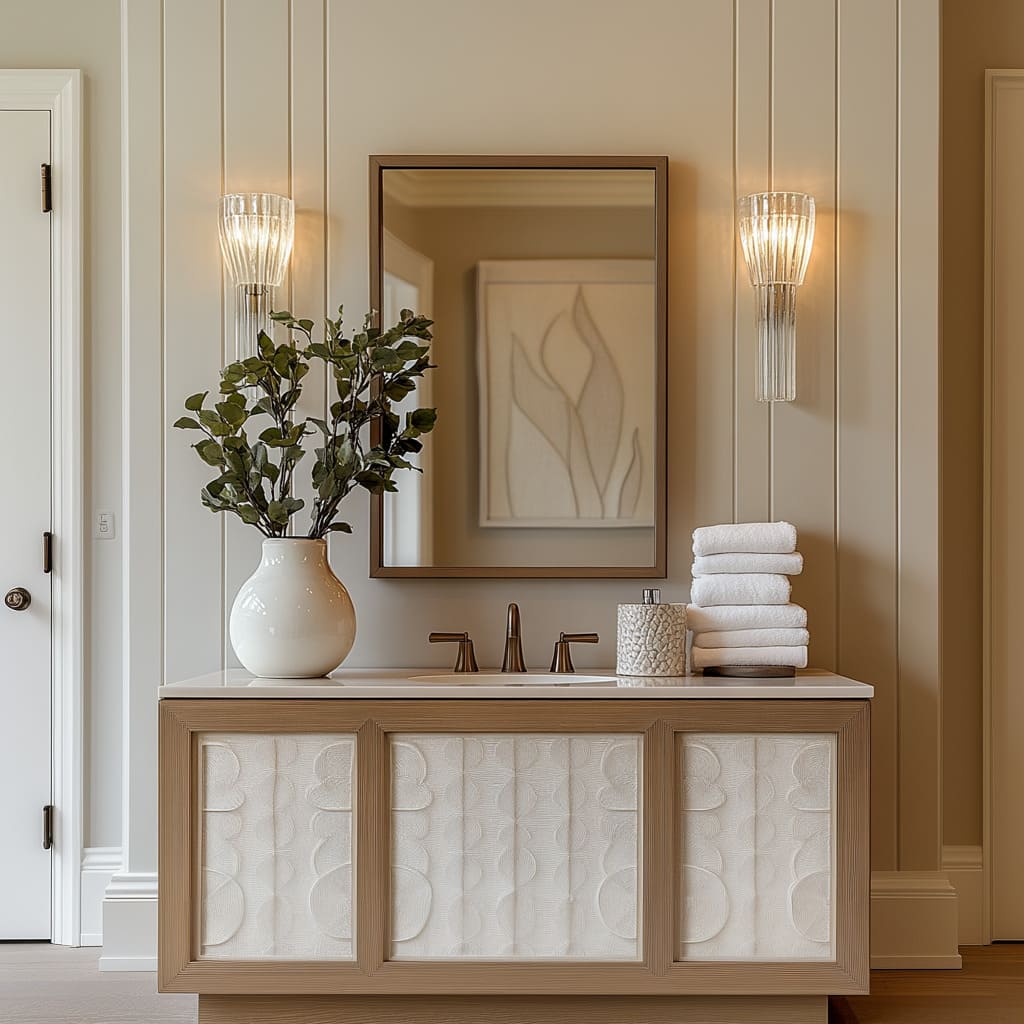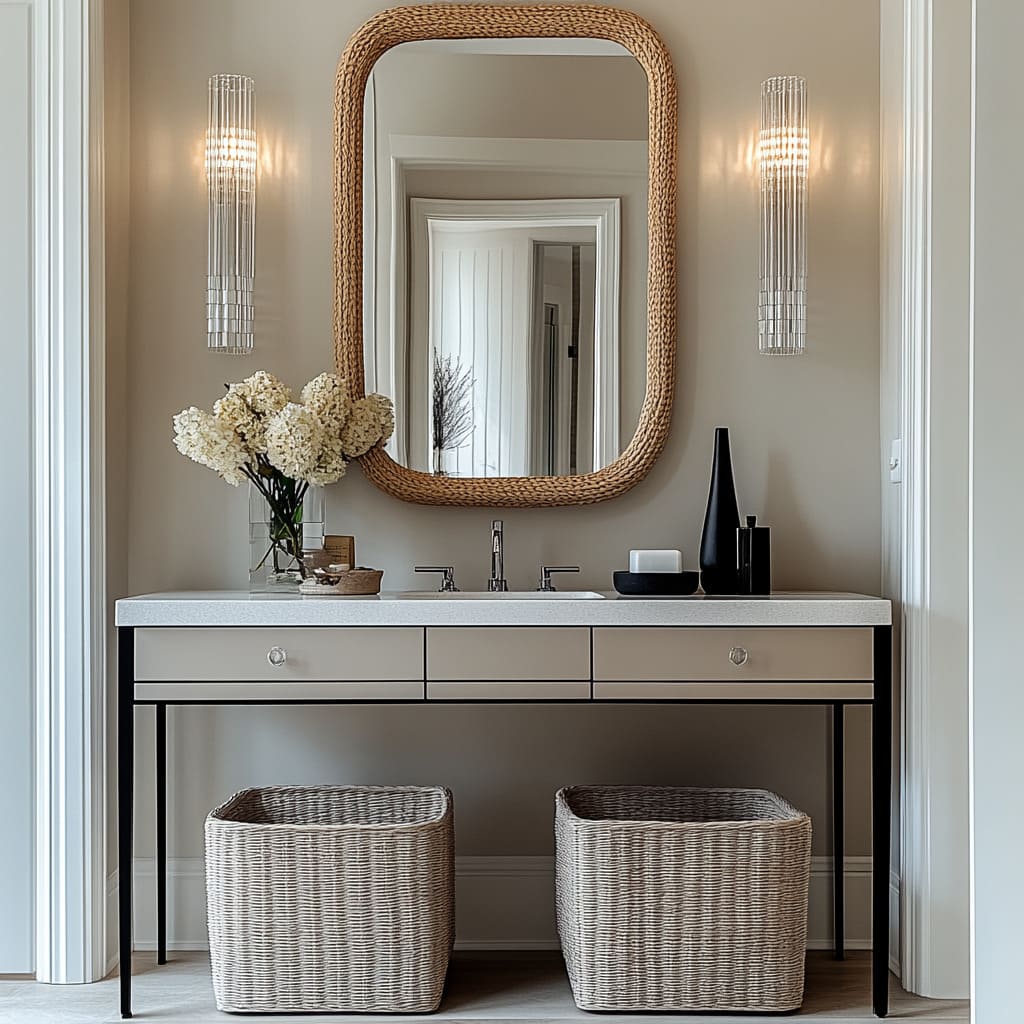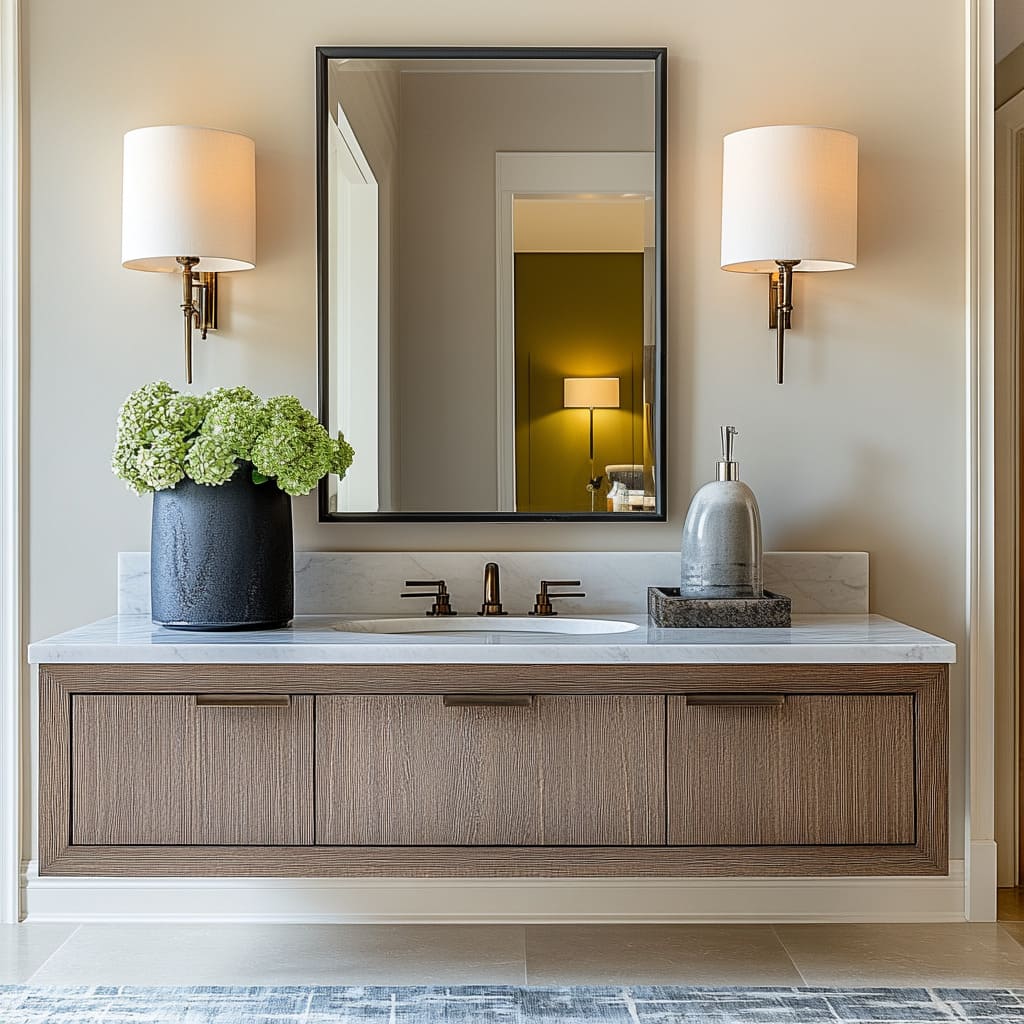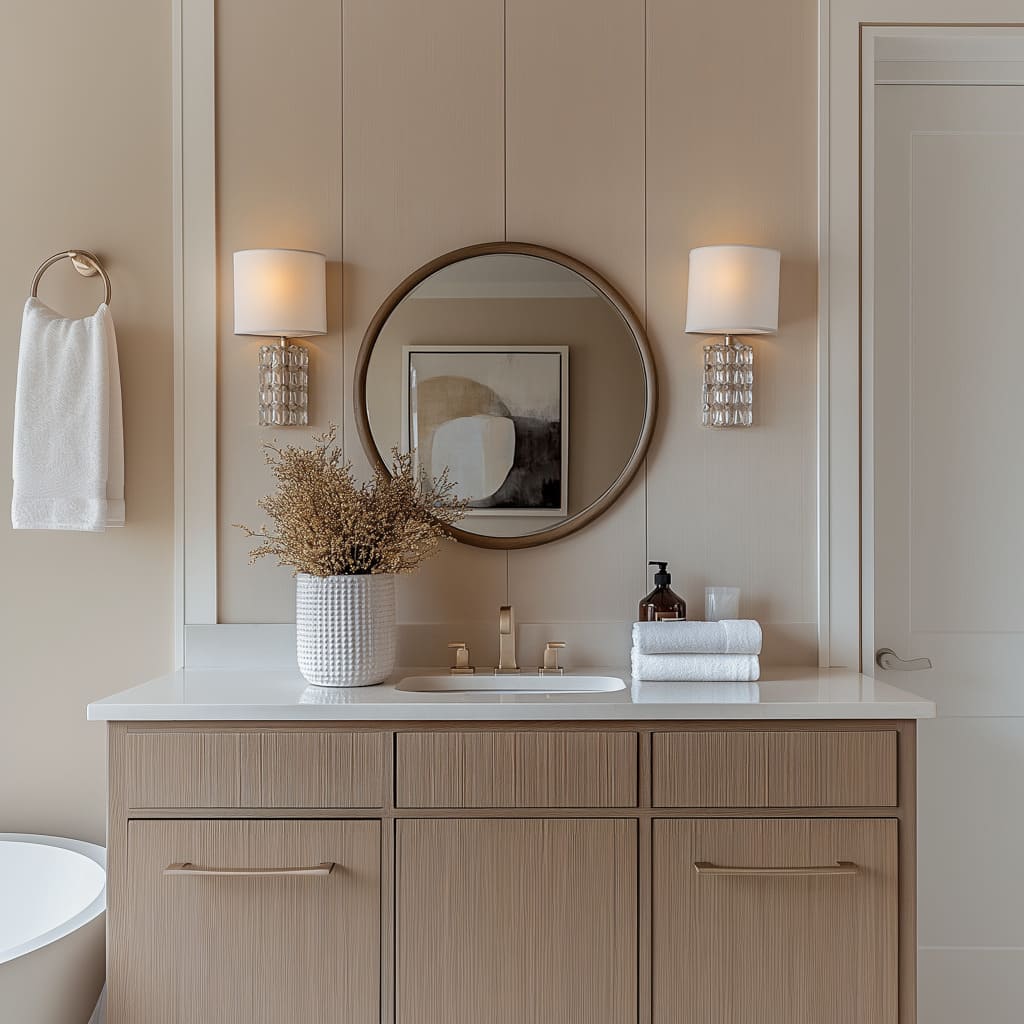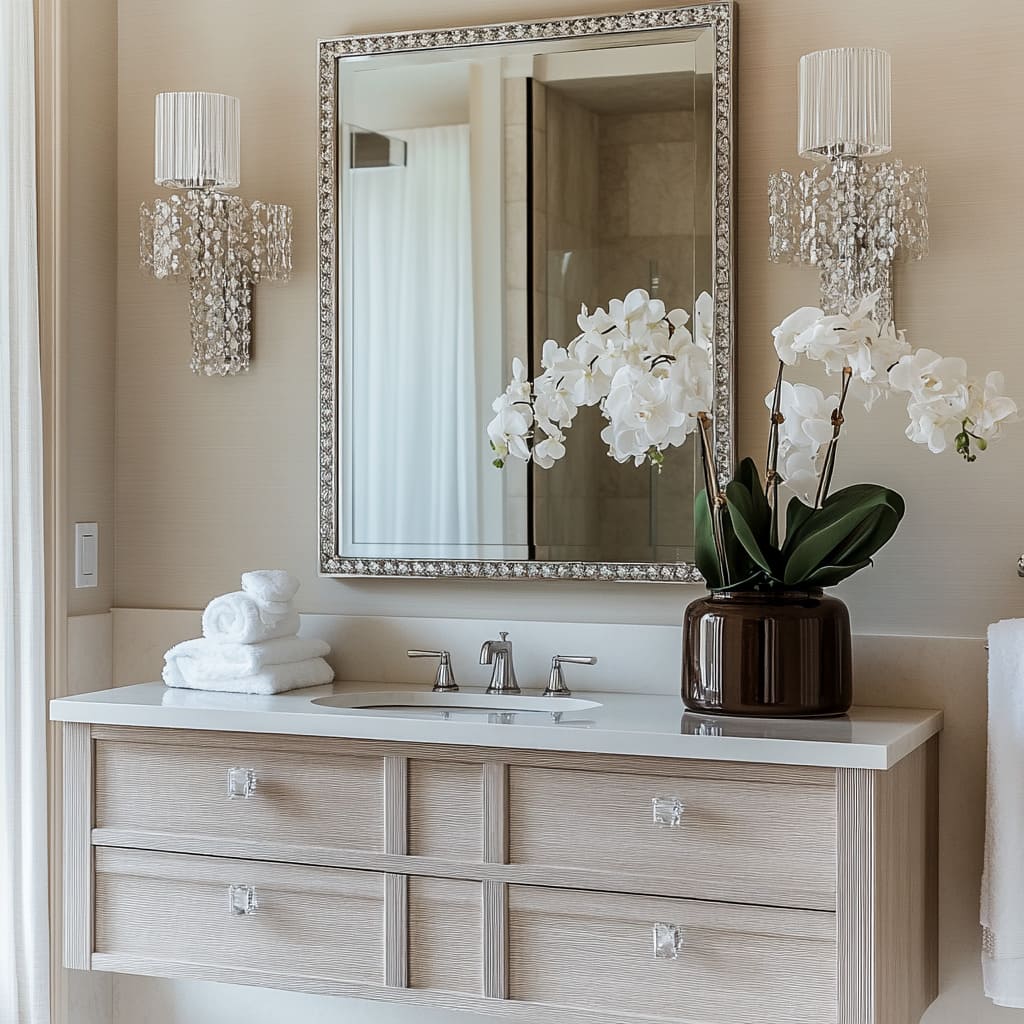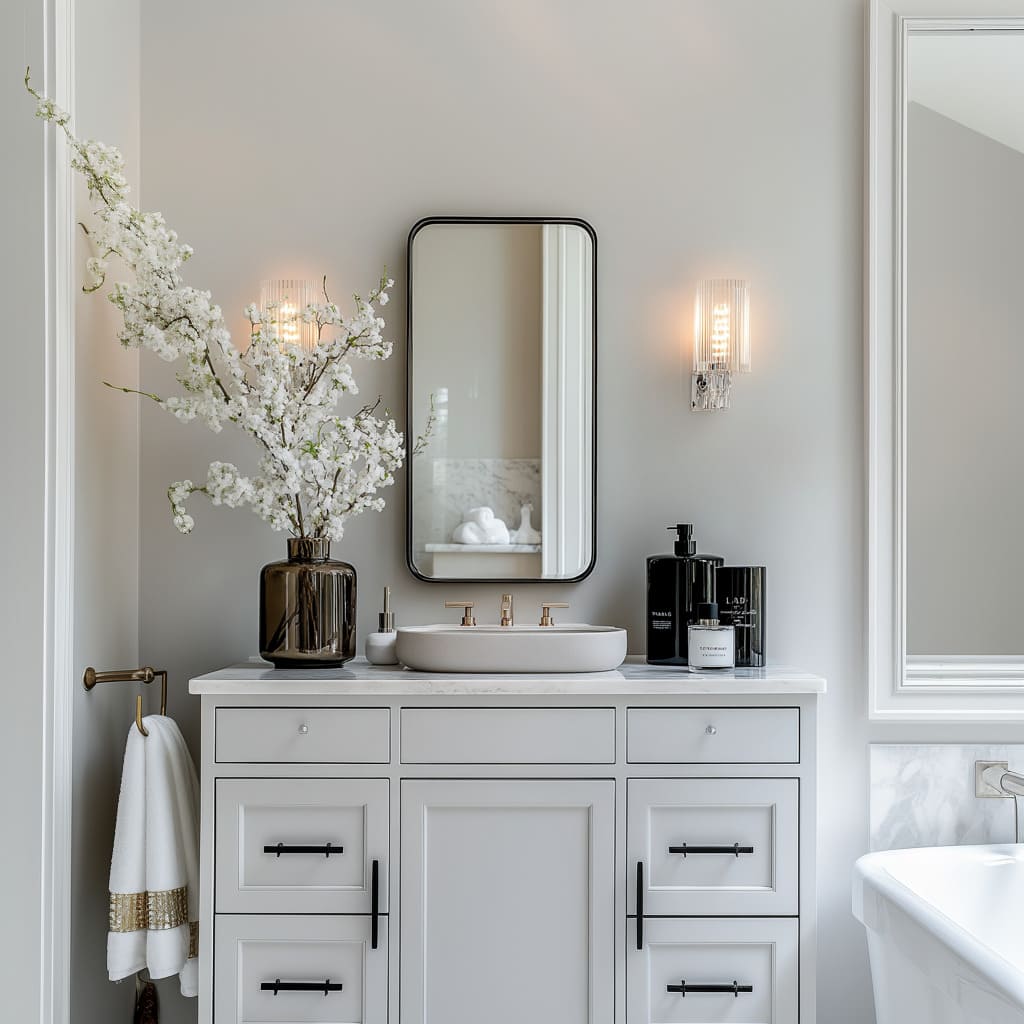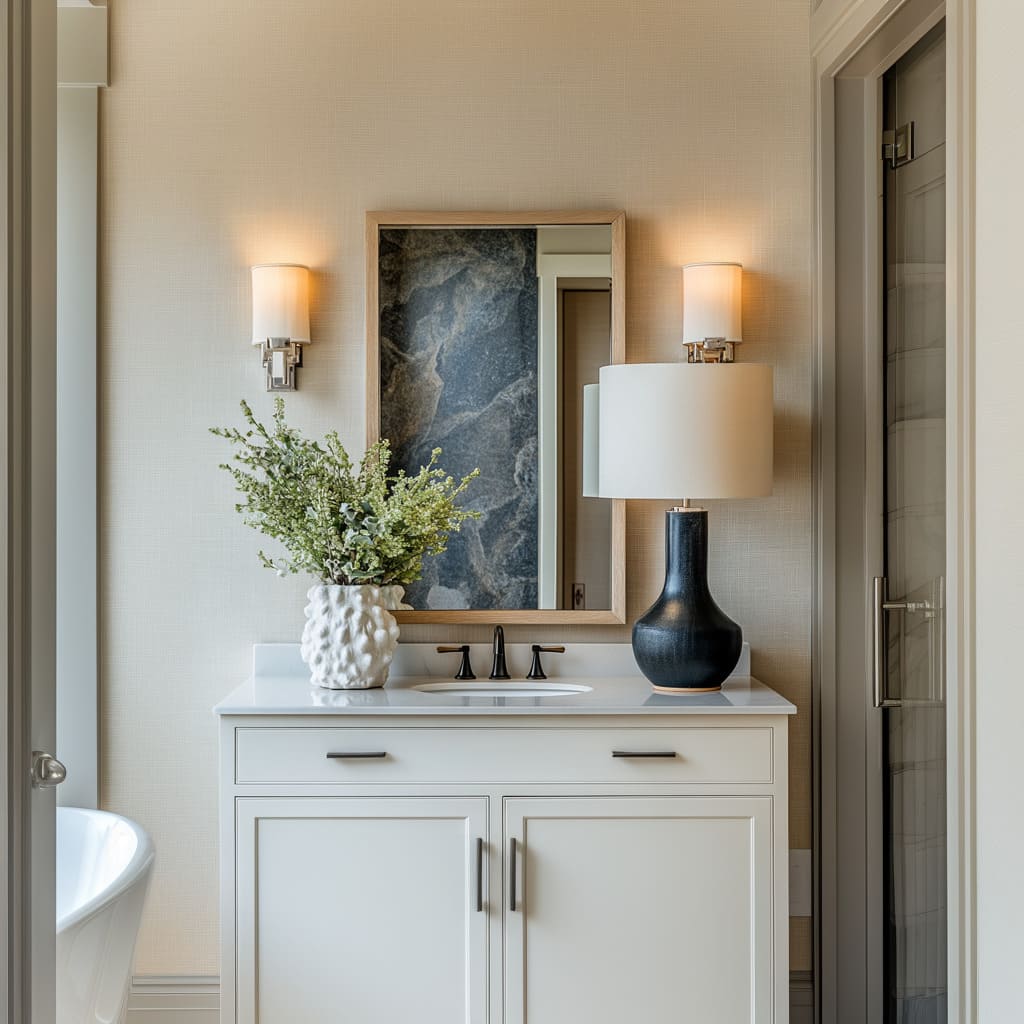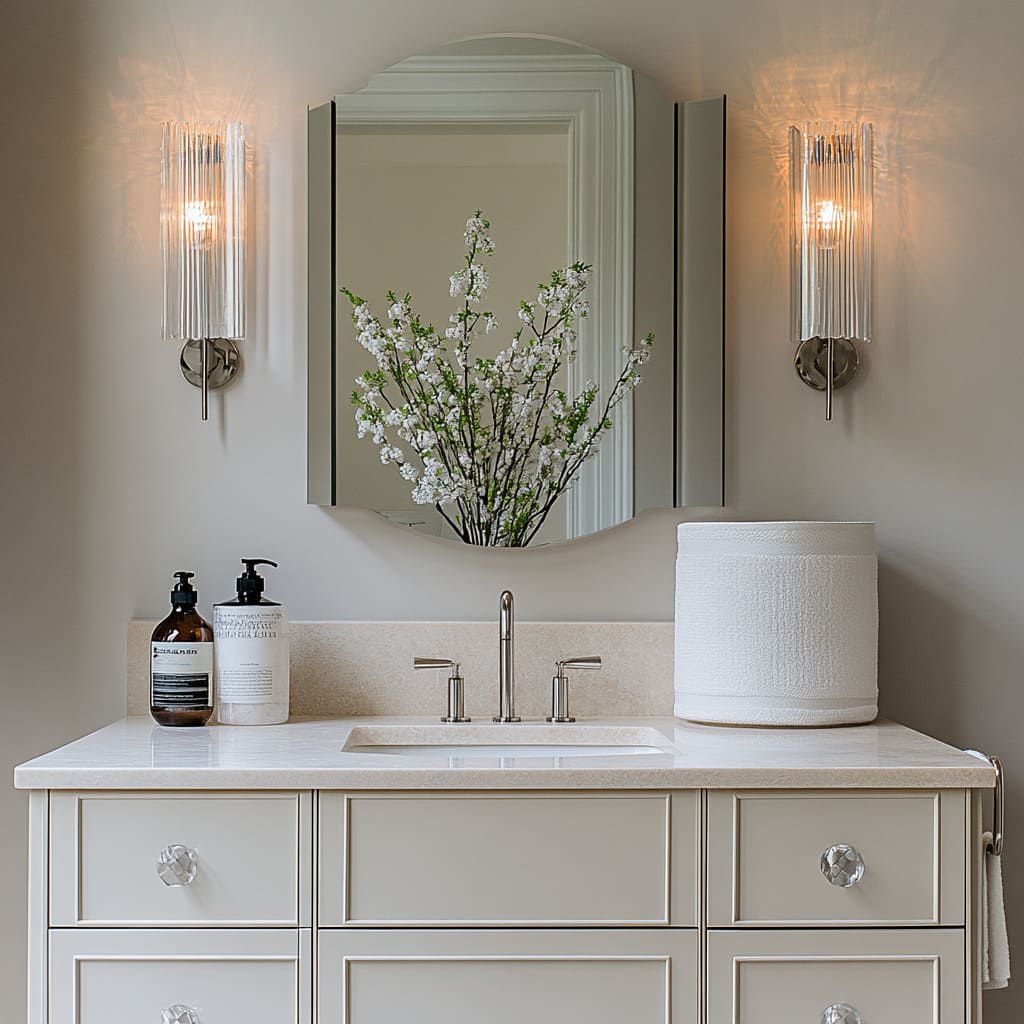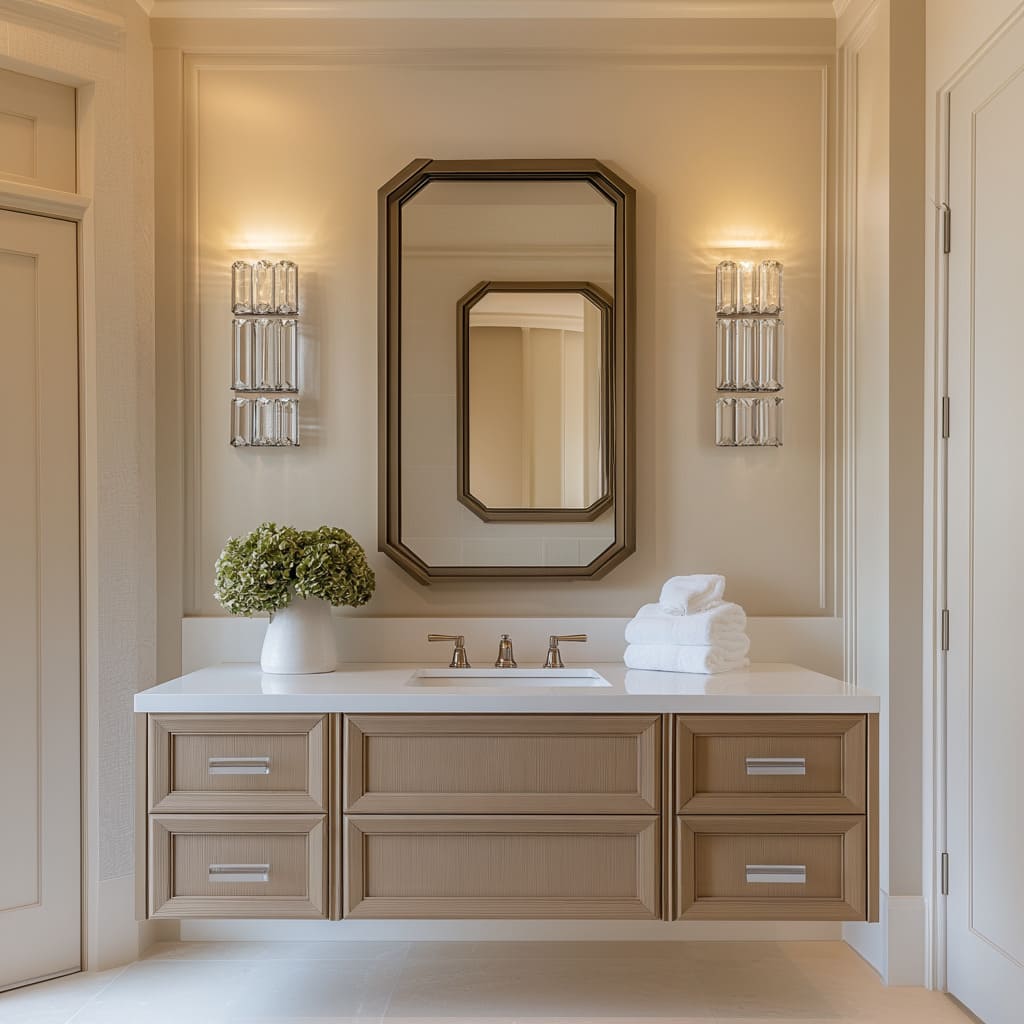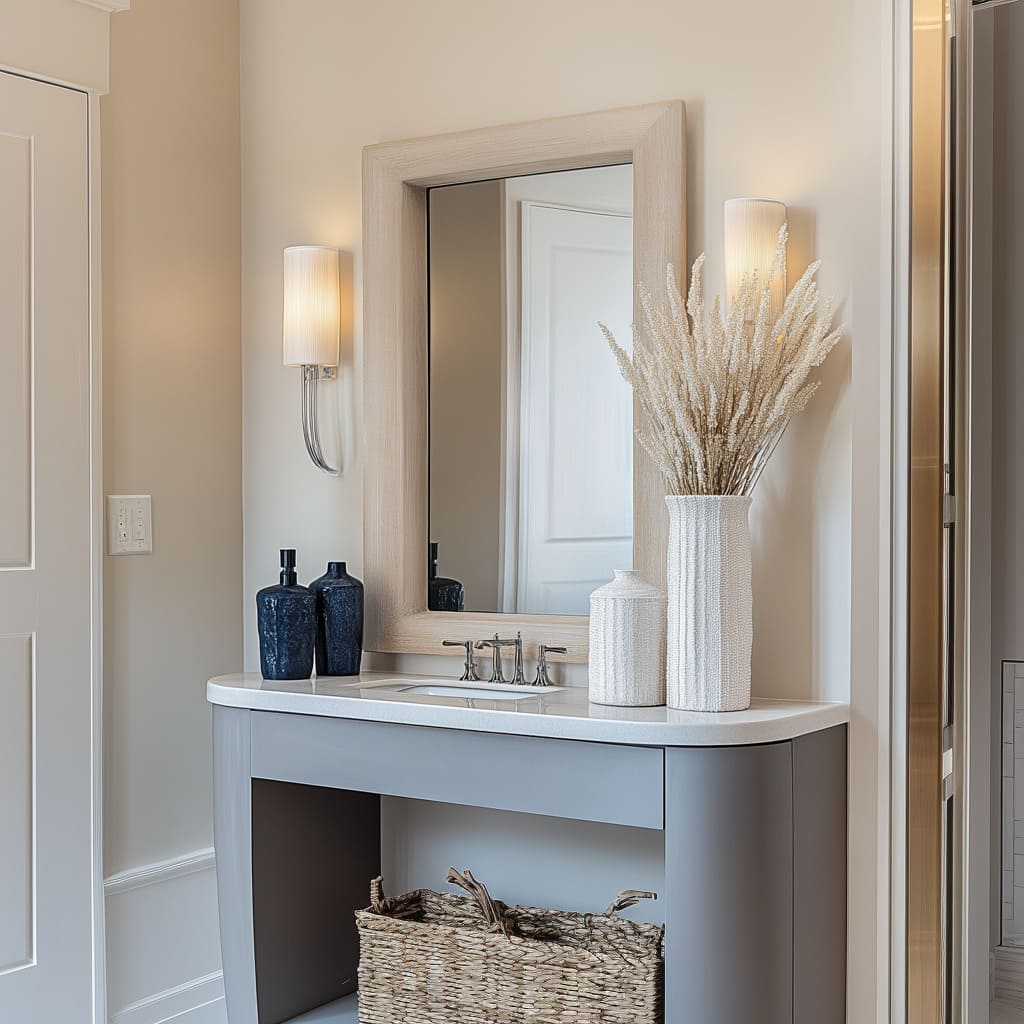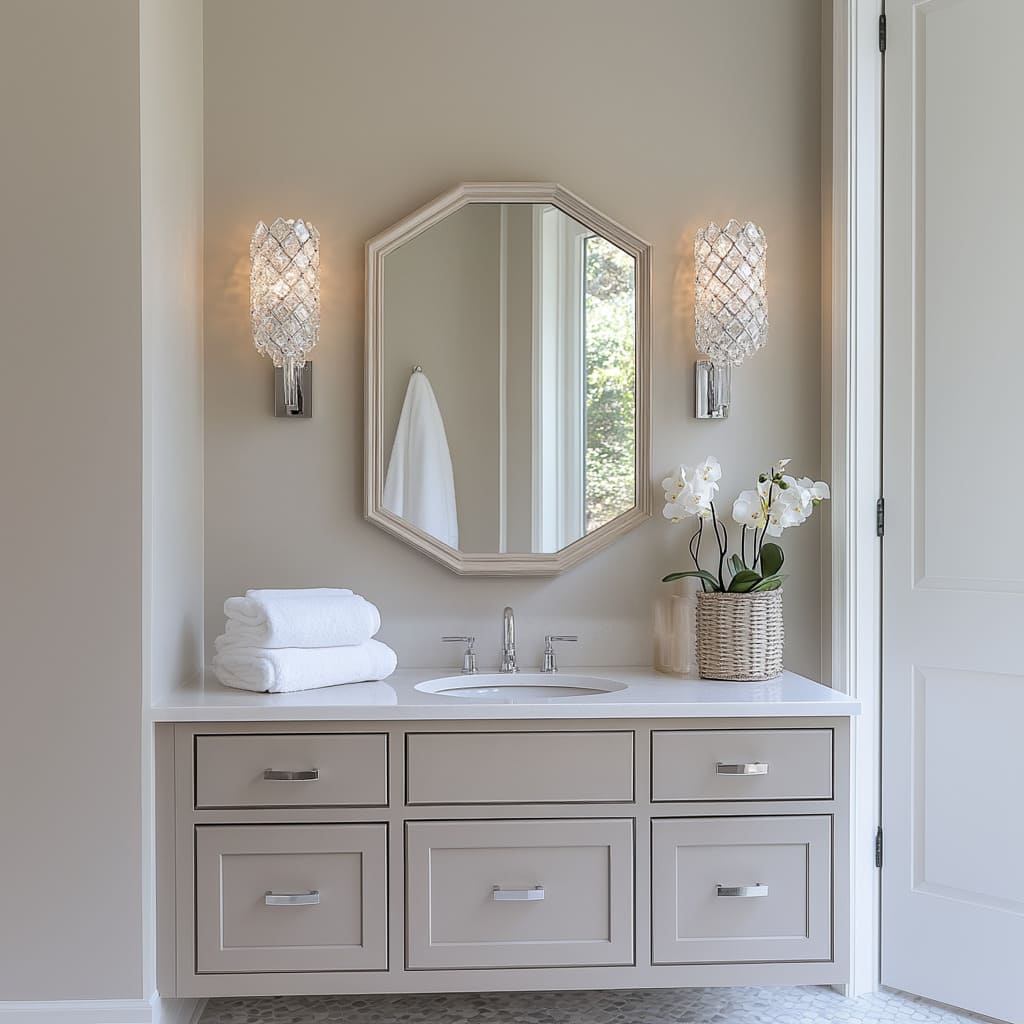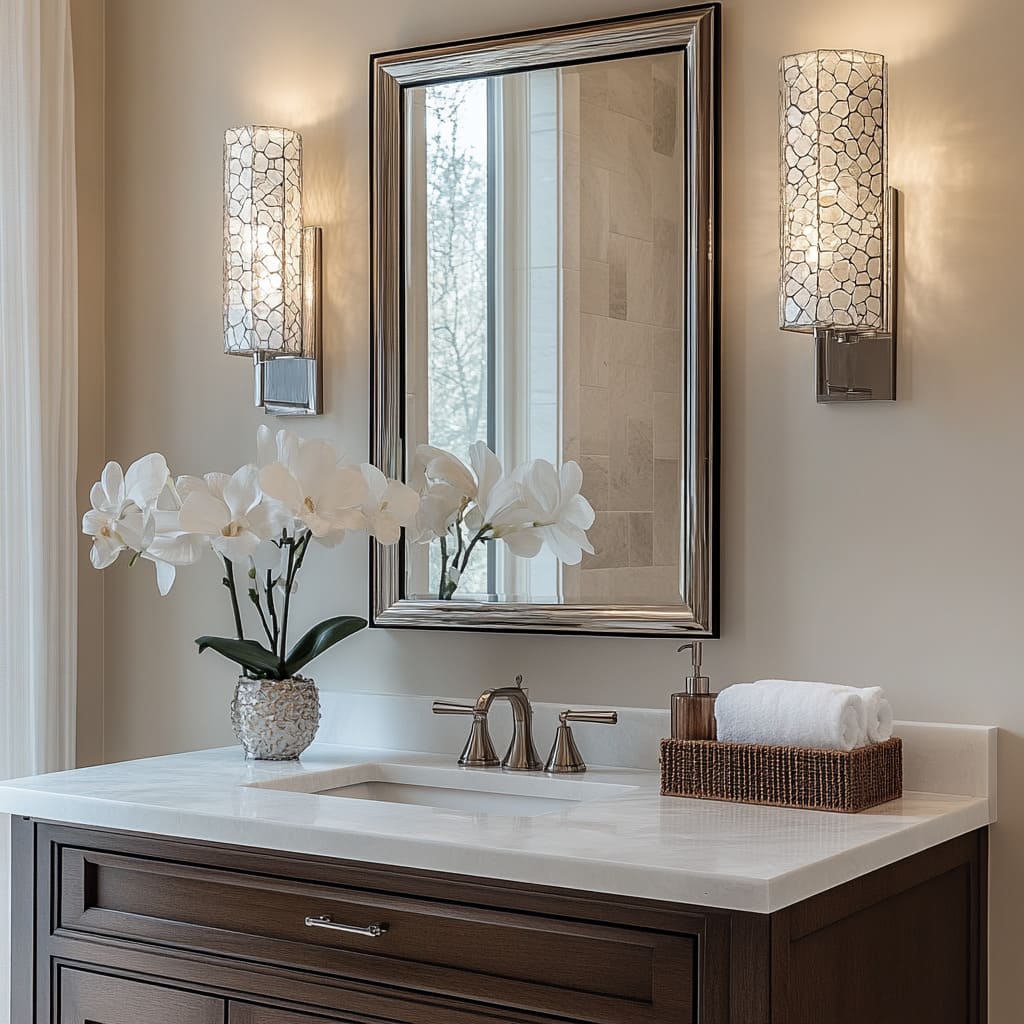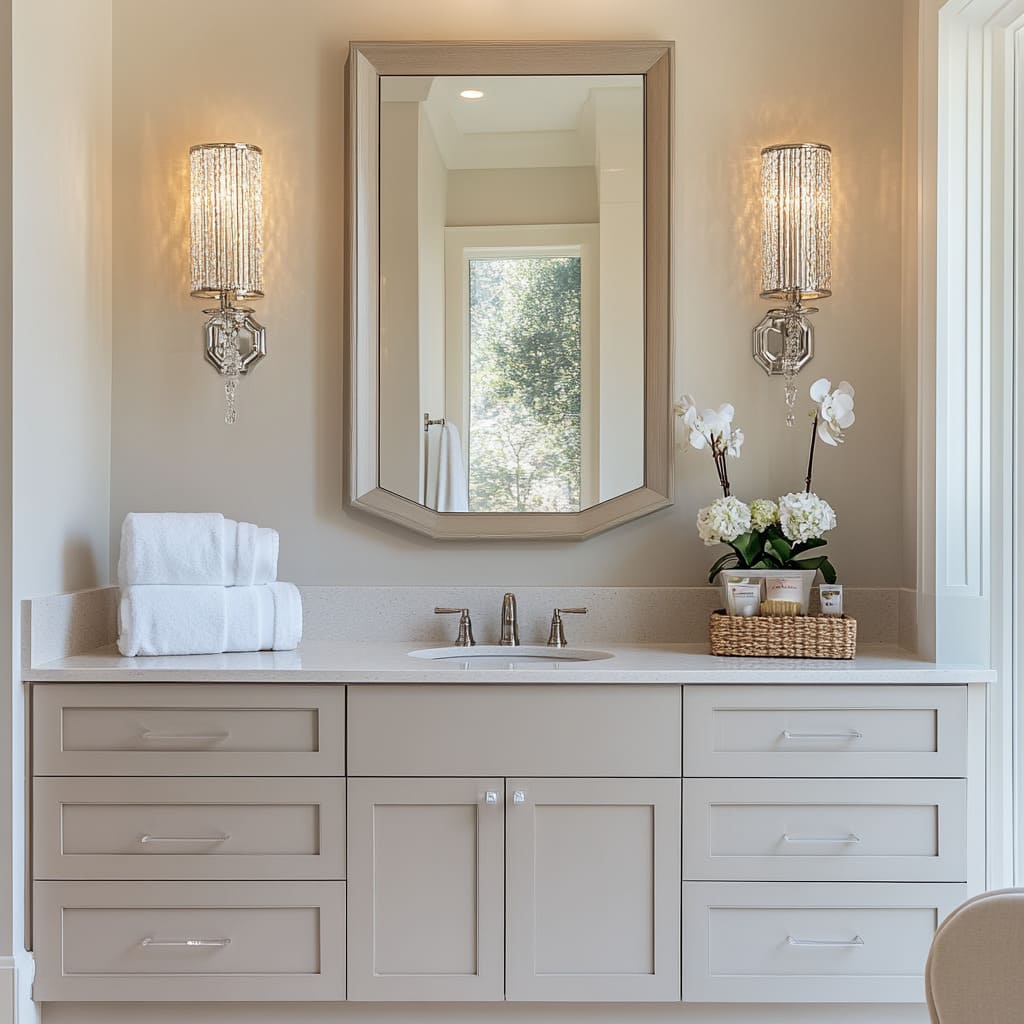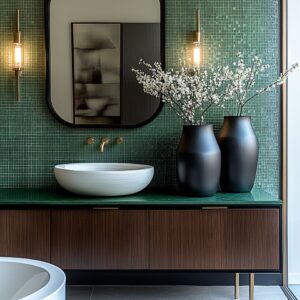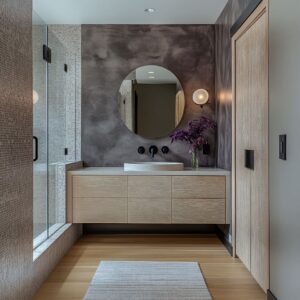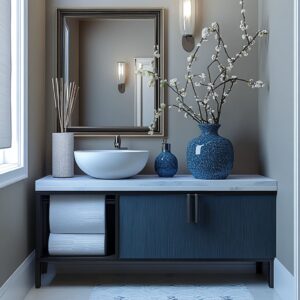Transforming a bathroom into a refined and practical space often starts with the centerpiece: the vanity. An elegant bathroom vanity not only sets the tone for the entire room but also balances beauty with functionality.
From the warmth of natural wood finishes to the subtle shine of metal accents, each design choice contributes to a harmonious and inviting atmosphere.
Whether you’re inspired by timeless neutral palettes, crave the luxurious appeal of polished stone countertops, or seek the perfect lighting to enhance your space, the possibilities are endless. This article dives deep into how thoughtful design elements—from mirrors and storage to color coordination—can elevate your bathroom into a personalized retreat while maintaining the practicality we all need.
Key Design Elements in Bathroom Vanities
When exploring elegant bathroom vanity design ideas, certain features consistently stand out, shaping both style and functionality. These elements, thoughtfully combined, create spaces that are both practical and visually captivating.
Let’s break down the essentials that define these vanities:.
Material Choices
The foundation of any vanity lies in its materials, and high-quality finishes remain a hallmark of refined design:
- Wood Finishes: Oak, walnut, and maple frequently take center stage. These woods are often left in their natural tones or enhanced with soft, neutral paints like beige, white, or gray. The texture and grain of these woods bring warmth and character, perfect for achieving a timeless appeal.
- Countertops: Quartz and marble are dominant players, chosen for their durability and luxurious aesthetic. These surfaces not only withstand daily use but also add a polished, high-end feel to the design.
- Hardware Accents: Handles and faucets in brushed nickel, chrome, or brass provide the finishing touch, harmonizing with the overall material palette. These metallic accents bring subtle sophistication without overpowering the space.
Color Coordination
Color plays a crucial role in setting the tone of the bathroom. Neutral palettes take the lead in many designs, offering a versatile and calming base:
- Primary Palette: Whites, grays, and beiges dominate, creating a clean and fresh look that suits both traditional and modern spaces.
- Accent Colors: Pops of color, introduced through decor items like green plants, black jars, or vibrant orchids, add personality. These thoughtful touches inject vibrancy without detracting from the overall harmony.
- Coordinated Details: Mirror frames, light fixtures, and hardware often echo one another in tone, tying the design together. For instance, warm brass light fixtures complement mirrors with golden finishes, enhancing the sense of cohesion.
Lighting Design
Lighting isn’t just functional in these designs—it’s a defining feature that transforms the space:
- Sconce Styles: Crystal or glass sconces are a popular choice, offering soft illumination that enhances the luxurious atmosphere. These fixtures often feature intricate designs that reflect light beautifully across the room.
- Placement and Effect: Lighting is strategically positioned beside or above mirrors, ensuring even, flattering light for daily grooming tasks. This placement eliminates harsh shadows while adding depth and warmth to the room.
By focusing on these design elements—materials, color coordination, and lighting—you can bring both style and utility to your bathroom. Whether your inspiration comes from modern minimalism or classic charm, these principles offer a strong foundation for creating a space that reflects your taste.
Crafting Cohesion in Bathroom Vanity Design
In exploring master bathroom vanity ideas, the interplay between various design elements becomes apparent. It’s not just about selecting beautiful features, but understanding how these components work together to create a harmonious and practical space.
Let’s delve into the relationships between these elements and how they shape the overall experience:.
Lighting and Countertop Reflection
The synergy between lighting and countertop materials is a defining aspect of vanity design:
- Polished Surfaces and Diffusion: Countertops made from materials like quartz or marble amplify the effect of lighting. The reflective surfaces spread light evenly across the space, resulting in a bright and open feel—perfect for compact or dimly lit bathrooms.
- Soft Illumination for Elegance: When paired with lighter color finishes, such as white or beige, lighting creates a soothing atmosphere that feels inviting yet refined. This combination works particularly well for spaces aiming for a spacious and airy ambiance.
Open Storage and Decoration
The inclusion of open storage adds both functionality and aesthetic value to bathroom vanities:
- Natural Aesthetics: Open storage solutions, like woven baskets or open shelves, highlight a preference for eco-friendly and natural decor. These details often work seamlessly with light wood tones or pastel color palettes, reinforcing a soft, organic style.
- Curated Displays: The visible nature of open storage encourages intentional styling. Stacked or rolled towels, ceramic jars, and minimalist vases with greenery add layers of texture and interest without overcrowding the design.
Mirror Shape and Room Perception
The choice of mirror shapes significantly impacts the overall feel of a bathroom:
- Rectangular Mirrors: These mirrors emphasize vertical lines, making the room feel taller—a handy design trick for bathrooms with lower ceilings. They pair well with modern or structured aesthetics.
- Round or Oval Mirrors: Softer shapes such as circular or oval mirrors add balance, especially in designs featuring organic elements like plants or wicker accessories. These mirrors contribute to a more relaxed and welcoming look.
Color and Mood
Color selection plays a vital role in setting the tone and energy of the bathroom:
- Warm Tones for Coziness: Hues like beige and light brown create a comforting and inviting atmosphere, making the bathroom feel like a tranquil retreat.
- Cool Tones for Modernity: Grays and whites, often staples of minimalist designs, convey a clean and contemporary aesthetic. When paired with simple decor, these tones offer a sleek and uncluttered appearance.
- Refreshing Accents: Adding green plants or fresh floral arrangements introduces vibrancy and contrast, breaking up neutral palettes and enhancing the room’s sense of liveliness.
By understanding the dynamic relationships between these elements—lighting, storage, mirrors, and colors—you can create a cohesive and visually pleasing bathroom design. These ideas provide not only inspiration but also practical insights for crafting a master bathroom vanity that perfectly reflects your style and needs.
Subtle Yet Impactful Insights for Bathroom Vanity Designs
When refining your bathroom’s aesthetic, certain details might not be immediately noticeable, yet they have a significant effect on the overall experience. These nuanced observations provide inspiration for homeowners aiming to create visually balanced and functional vanities.
Crystal Lighting and Texture Interaction
Crystal light fixtures introduce an interplay of light and texture that elevates the atmosphere of any bathroom. When paired with textured vanity finishes, such as ribbed wood or painted surfaces, these fixtures project intricate light patterns that shift throughout the day.
This creates a sense of movement and depth, offering a dynamic element that evolves with changing light conditions. For example, textured finishes can amplify the shimmering reflections cast by crystal sconces, creating an eye-catching focal point without overwhelming the space.
This combination works particularly well in bathrooms with a mix of matte and glossy materials, balancing bold accents with subtle sophistication.
Hidden Symmetry in Design
While asymmetrical decor arrangements (like placing a vase on one side and a towel rack on the other) add personality, the symmetry of the core design—achieved through balanced mirror placement and lighting—ensures the composition feels anchored. This underlying symmetry prevents the layout from feeling chaotic, subtly guiding the eye and enhancing harmony in the space.
The result is a design that feels curated yet approachable, where intentional asymmetry creates interest, and the structured arrangement brings calm. This approach is especially effective for homeowners who value personalized touches while maintaining an organized look.
Drawer Handles as Decorative Highlights
Handles and knobs are no longer mere functional details; they’re becoming statement pieces in their own right. Faceted crystal handles or uniquely crafted metal knobs in brushed brass or blackened steel can add a touch of artistry, acting as jewelry for the vanity.
These small accents can tie the entire design together, echoing tones or textures found in lighting fixtures, faucets, or decor items. For instance, a bathroom with gold-accented fixtures might feature matching drawer handles with intricate detailing, subtly reinforcing the overall theme.
Layering Decor for Depth
Layering is a strategic way to introduce depth and dimension to your vanity space. By placing a tray on the countertop and styling it with small bottles, candles, or fresh flowers, you create a visually rich scene that feels intentional and refined.
This method also helps organize smaller items, keeping the vanity clean while adding a decorative layer. For those who prefer a minimalist approach, layering can be as simple as a sleek soap dispenser paired with a single vase, creating understated charm without clutter.
These thoughtful vanity ideas not only enhance functionality but also allow homeowners to infuse personality into their spaces. By paying attention to the interplay of lighting, textures, symmetry, and decor, you can transform your bathroom into a sanctuary that reflects both style and practicality.
Practical Considerations for Bathroom Vanity Design
While the aesthetic appeal of vanities often takes center stage, functionality is equally important for creating a bathroom that not only looks great but also works seamlessly in daily life. The following key features blend practicality with style, offering inspiration for modern bathroom vanity ideas.
Soft-Close Drawers and Doors
Soft-close mechanisms are a hallmark of high-quality vanities. These features not only reduce noise but also extend the life of your furniture by minimizing wear and tear caused by frequent slamming.
For busy households, this detail ensures the bathroom remains a quiet, serene space, even during hectic mornings. Soft-close designs are particularly beneficial for families, as they help prevent children from accidentally pinching their fingers.
Additionally, the smooth operation adds a subtle sense of luxury to everyday use, making even the smallest task feel more refined.
Integrated Outlets for Convenience
Modern vanities have evolved to accommodate the growing number of grooming devices in bathrooms. Built-in outlets, often discreetly tucked inside drawers, allow users to charge toothbrushes, razors, or even hair tools without cluttering the countertop.
This thoughtful integration is especially valuable for maintaining a clean, streamlined vanity surface. By keeping cords and devices hidden, these vanities strike the perfect balance between technology and design.
Elevated Vanities for Hygiene and Style
Vanities mounted on legs or directly onto the wall are becoming increasingly popular for both practical and aesthetic reasons. Elevated designs make it significantly easier to clean underneath, helping to maintain better hygiene in one of the home’s most frequently used spaces.
In terms of design, raised vanities lend a sense of openness to the room, particularly in smaller bathrooms where floor space is at a premium. The visual effect of a floating vanity creates a lighter, more spacious atmosphere without sacrificing storage.
Decor that Balances Function and Style
Adding decor to your vanity is about more than just filling space—it’s an opportunity to bring personality and warmth to the bathroom. Elements like potted plants, textured towels, or sleek ceramic jars can make the room feel more inviting.
Practical decor pieces, such as soap dispensers, storage trays, and small baskets, are often selected to match the overall aesthetic. For example, a minimalist bathroom might use monochromatic accessories, while a bohemian-inspired space could include woven textures or earthy ceramics.
These touches ensure that the room feels cohesive while remaining functional for everyday use. By prioritizing features that enhance usability, homeowners can achieve a balance between beauty and practicality.
Whether through innovative storage solutions or carefully selected decor, these insights make it clear that a well-designed vanity is as much about function as it is about style.
Patterns in Mirror and Lighting Pairings for Bathroom Design
When designing a bathroom, the relationship between mirrors and lighting plays a pivotal role in shaping both functionality and ambiance. Analyzing different pairings highlights how these elements work together to elevate the overall design.
Below are key insights into popular combinations, along with practical applications for homeowners exploring bathroom vanity mirror ideas.
Large Mirrors for Expansiveness
Incorporating oversized mirrors into bathroom designs is a tried-and-true strategy for amplifying the sense of space. These mirrors, often spanning the width of the vanity or more, reflect natural and artificial light to brighten the room and visually enlarge smaller bathrooms.
Paired with understated lighting, such as recessed lights or minimal sconces, large mirrors shift the design focus to openness and reflection. This approach works particularly well in bathrooms with light-colored walls and clean-lined vanities, where the simplicity of the lighting enhances the mirror’s impact without competing for attention.
Mirrors with Decorative Frames as Statement Features
Mirrors with intricate or bold frames serve as focal points, introducing a sense of artistry and sophistication. Whether adorned with metallic accents, carved wood, or unique geometric patterns, these framed mirrors often complement neutral or subdued wall colors, ensuring the overall space remains balanced and harmonious.
For example, a decorative mirror in brushed brass might pair beautifully with soft beige walls, while crystal-framed mirrors bring glamour to minimalist gray bathrooms. This combination ensures the mirror stands out without overwhelming the design, making it both functional and visually engaging.
Vertical Sconces for Balanced Illumination
Lighting positioned on either side of the mirror is not only aesthetically pleasing but also highly practical. Vertical sconces provide even, shadow-free illumination, making them ideal for grooming tasks such as applying makeup or shaving.
To enhance brightness and elegance, many designs incorporate glass or crystal sconces. These materials reflect light onto adjacent surfaces, such as countertops and mirror frames, creating a luminous effect that feels both refined and functional.
When paired with simple, rectangular mirrors, vertical sconces add structure and symmetry to the vanity area.
The Intersection of Mirrors and Lighting Design
What becomes clear in these pairings is how mirrors and lighting work hand in hand to shape the bathroom’s atmosphere. Large mirrors amplify light, decorative frames add personality, and vertical sconces ensure practical functionality—all while creating a cohesive and inviting space.
For homeowners, understanding these relationships can help achieve a bathroom design that feels both polished and thoughtfully planned.
Practical Tips for Enhancing Your Bathroom Design
Drawing from the analysis of bathroom design trends, here are actionable tips to create a sophisticated yet functional space. These ideas blend style and practicality, helping you achieve a bathroom that feels both luxurious and user-friendly.
Choose a Coordinated Palette
A well-planned color palette sets the tone for your bathroom’s design. Stick to two or three foundational colors and a single accent hue to avoid visual clutter.
For instance, a combination of white and gray with brass accents delivers a timeless look that feels polished. If you prefer a softer approach, pastel tones paired with natural wood finishes can evoke a calm and welcoming vibe.
Prioritize Lighting Placement
Strategically placed lighting can transform the functionality and appearance of your bathroom. Sconces mounted at eye level on either side of the mirror provide even, flattering illumination, making grooming routines easier.
For spaces where ceiling fixtures are the only option, opt for diffused bulbs that minimize harsh shadows while creating a balanced light source.
Invest in Storage Solutions
A bathroom that balances aesthetics with organization is always appealing. Include a mix of open and closed storage options to cater to both practical needs and decorative styling.
Closed cabinets keep essentials hidden, maintaining a clean look, while woven baskets or natural-material bins add warmth and texture to open shelves.
Select a Statement Mirror
A mirror can act as a focal point, so its design should complement the rest of the space. Mirrors with ornate frames stand out beautifully against minimalist fixtures, adding personality to a neutral bathroom.
Alternatively, sleek, simple mirror frames create harmony when paired with more decorative vanity hardware or lighting.
Layer Decor Thoughtfully
Well-placed decor items elevate your bathroom without making it feel cluttered. For countertops, choose a few key pieces, such as a small potted plant, a decorative tray for holding soaps or bottles, or neatly folded towels.
This approach creates a balanced look while keeping surfaces functional and easy to clean.
Customize Vanity Dimensions
A vanity tailored to your bathroom’s proportions not only improves usability but also enhances the overall design. In compact bathrooms, a floating vanity creates an illusion of space, making the room feel less confined.
For larger spaces, a double vanity provides practicality while reinforcing a sense of balance and grandeur. If you’re exploring master bath vanity ideas, consider vanities with integrated storage and double sinks to maximize convenience without compromising on style.
By integrating these tips into your design process, you’ll create a bathroom that feels personalized, stylish, and practical. Whether you’re working with a small powder room or a spacious master bath, these recommendations ensure your space is both functional and visually appealing.
Final Thoughts
Creating a bathroom that truly stands out involves balancing visual appeal with everyday practicality. The most successful designs focus on using premium materials, well-placed lighting, and curated decor elements that together form a cohesive and inviting space.
Attention to these finer details elevates the experience of the room, ensuring it feels thoughtfully composed and highly functional.
The patterns and relationships between elements like lighting, mirror pairings, and storage solutions highlight how each feature contributes to the overall aesthetic. For instance, integrating lighting that enhances the reflective qualities of polished surfaces, or using open storage to bring in textures like woven baskets or ceramics, can give your bathroom added personality while maintaining its purpose.
When planning your design, taking cues from luxury bathroom vanities ideas can provide both inspiration and direction. Look for ways to subtly incorporate your preferred style, whether it’s through a statement mirror frame, textured drawer handles, or layering decorative accents to create depth.
By combining these strategies, you can achieve a bathroom that feels polished, inviting, and tailored to your needs.
